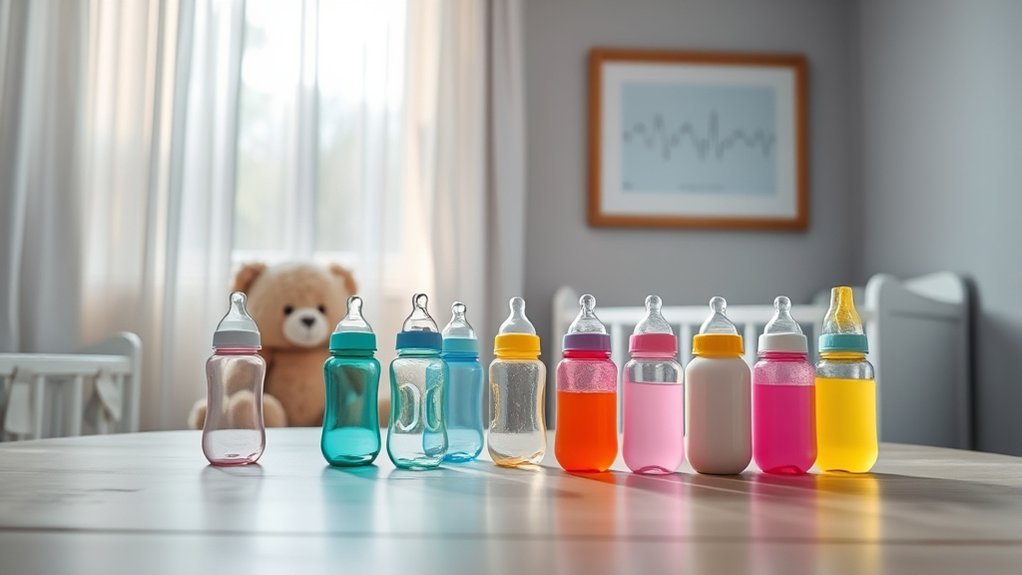Choosing the right baby bottle can feel like steering through a maze, and it’s essential to know when you might need a guiding hand. As you explore options, you may encounter signs that indicate your baby needs more than just a new bottle. Understanding these signals can make all the difference in ensuring your little one’s health and comfort. So, what should you look out for?
Understanding Different Types of Baby Bottles
When you’re choosing baby bottles, it’s essential to understand the different types available to find the best fit for your little one. There are mainly three types: standard bottles, angled bottles, and wide-neck bottles. Standard bottles have a traditional shape and are compatible with most nipples. Angled bottles feature a slanted design, helping to reduce air intake and minimize gas. Wide-neck bottles are easier to clean and fill, providing a more natural feeding experience. Additionally, you’ll find options made from plastic, glass, or silicone, each with its own pros and cons. Consider your baby’s feeding preferences and any potential sensitivities when deciding. Knowing these options helps you make an informed choice, ensuring a comfortable feeding experience for both you and your baby.
Factors to Consider When Choosing a Bottle
As you consider which baby bottle to choose, several key factors can greatly impact your decision. Think about the material, nipple flow, and ease of cleaning. Each element plays a crucial role in your baby’s feeding experience.
| Factor | Considerations |
|---|---|
| Material | Glass, plastic, or silicone? |
| Nipple Flow | Slow, medium, or fast flow? |
| Ease of Cleaning | Dishwasher safe or manual wash? |
| Size and Shape | Ergonomics for you and your baby? |
Choose a bottle that fits your lifestyle and your baby’s preferences. Ensuring comfort and safety will make feeding times more enjoyable for both of you. Always keep your baby’s needs at the forefront of your decision.
Common Feeding Issues and Their Symptoms
Feeding your baby can sometimes come with challenges, and recognizing common feeding issues is vital for promoting a smoother experience. Many parents encounter symptoms like excessive fussiness during feeds, which may indicate your baby is struggling with latch or bottle flow. If you notice your baby arching their back or turning away from the bottle, they might be experiencing discomfort or are simply not hungry. Frequent spit-ups or signs of gagging could suggest you need to adjust the nipple size or flow rate. Additionally, if your baby seems to be feeding very slowly or takes longer than usual to finish, it might be worth evaluating the bottle’s design. Understanding these symptoms helps guarantee your baby’s feeding experience is comfortable and enjoyable.
When to Seek Medical Advice
Recognizing feeding issues is important, but knowing when to seek medical advice can make a significant difference in your baby’s well-being. If your baby shows signs of dehydration, like a dry mouth or fewer wet diapers, it’s critical to contact your pediatrician. Don’t hesitate to reach out if your little one refuses to eat or drink for more than a few hours, as this could indicate a more serious problem. Additionally, if you notice persistent vomiting, unusual fussiness, or signs of an allergic reaction, it’s time to get professional help. Always trust your instincts; if something feels off, consult with your healthcare provider for guidance. Your baby’s health is paramount, and prompt action can guarantee they receive the care they need.
Tips for Transitioning Between Bottles
Shifting between bottles can be a smooth process if you approach it with patience and care. Start by introducing the new bottle gradually, perhaps during a calm feeding time. You might find it helpful to let your baby explore the new bottle without pressure. If your baby resists, don’t force it; try again later. Mixing breast milk or formula from their preferred bottle into the new one can make the change easier. You should also consider the flow rate; if the new bottle has a faster flow, it might be overwhelming. Consistency is key, so use the new bottle regularly but still keep the old one available for comfort. Most importantly, stay positive and supportive throughout the shift.
Frequently Asked Questions
How Often Should I Clean Baby Bottles?
You should clean baby bottles after every use. Thoroughly wash them with warm, soapy water or in the dishwasher. Regular cleaning prevents bacteria buildup, ensuring your baby stays healthy and safe during feeding times.
Can I Use Regular Dish Soap for Bottle Cleaning?
You can use regular dish soap to clean baby bottles, but it’s essential to guarantee it’s free from harsh chemicals. Rinse thoroughly; any residue could harm your baby. Always prioritize safety and cleanliness for your little one.
What Temperature Should Baby Formula Be Served At?
Baby formula should be served at body temperature, around 98.6°F (37°C). Gently warm it in a bottle warmer or a bowl of warm water, but avoid the microwave, which can create hot spots.
How Long Can I Store Prepared Formula?
Prepared formula’s like fresh bread—best used within two hours at room temperature or stored in the fridge for up to 24 hours. After that, discard it to guarantee your baby’s safety and health.
Are There Signs of Bottle Nipple Wear to Watch For?
Yes, watch for cracks, tears, or discoloration on the nipple. If it feels sticky or develops a foul odor, it’s time to replace it. Regularly inspect nipples to guarantee your baby’s feeding is safe and healthy.
Conclusion
In choosing the right baby bottle, remember it’s like finding the perfect puzzle piece—everything needs to fit just right for a smooth feeding experience. Keep an eye on your baby’s cues and trust your instincts; if you notice signs of dehydration or unusual fussiness, don’t hesitate to reach out to your pediatrician. Prioritizing your baby’s health and comfort guarantees a positive feeding journey, making both you and your little one happier in the long run.
